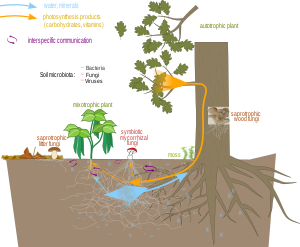Mycorrhizal network
In forests, trees' roots connect underground to each other with the facilitation of vast networks of fungi that facilitate mycorrhiza, or tree-fungi symbiosis. Trees use the networks to share nutrients and information with each other. The fungi benefit by taking some of the carbon-rich sugars the trees generate in photosynthesis. New York Times science journalist Ferris Jabr comments that the process displays an "interspecies selflessness of trees, however — a practice that verges on socialism."[1]
The existence of mycorrhizal networks confirms the traditional knowledge of indigenous peoples according to the forest ecologist Sm’hayetsk Teresa Ryan, of Tsimshian heritage, "There are many aboriginal groups that will tell you stories about how all the species in the forests are connected, and many will talk about below-ground networks.”
Although trees recognize their kin and are especially cooperative with relatives, they also share with members of other species. In North America, tall birch trees send carbon to shaded fir trees in the summer, and fir trees send carbon to the birch trees in the winter. Forest ecologist Suzane Simard remarks, “So it turns out the two species were interdependent, like yin and yang.”[2]
"Survival of the fittest" does not apply to trees in the forests. Strong trees need the weaker trees to survive in order to keep the hot sun and rough winds from ruining the cool, moist forest floor.[3]
Many plants rely extensively on the mycorrhizal networks. All orchids, for example, spend at least some of their youth taking from the network without giving anything back. About ten percent of plant species behave this way their whole lives.[4]
- ↑ Ferris Jabr, "The Social Life of Forests," New York Times, 2 December 2020, https://www.nytimes.com/interactive/2020/12/02/magazine/tree-communication-mycorrhiza.html.
- ↑ Suzane Simard, "How trees talk to each other," TED, 2016, https://www.ted.com/talks/suzanne_simard_how_trees_talk_to_each_other/transcript.
- ↑ Peter Wohlleben, The Hidden Life of Trees: What They Feel, How They Communicate trans. Jane Billinghurst (Vancouver: Greystone Books, 2016), 17.
- ↑ Merlin Sheldrake, Entangled Life: How Fungi Make Our Worlds, Change Our Minds & Shape Our Futures (New York: Random House, 2020), 156.
